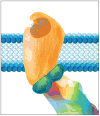A Receptor on Acid
- PMID: 28129534
- PMCID: PMC5520807
- DOI: 10.1016/j.cell.2017.01.012
A Receptor on Acid
Abstract
Wacker et al. report the crystal structure of LSD in complex with one of its major targets in the brain, the 5-HT2B receptor, the first such structure for any psychedelic drug. The results shed light on the molecular mechanisms underlying its ability to induce hallucinations with greater duration and potency than closely related compounds.
Copyright © 2017 Elsevier Inc. All rights reserved.
Figures

Comment on
-
Crystal Structure of an LSD-Bound Human Serotonin Receptor.Cell. 2017 Jan 26;168(3):377-389.e12. doi: 10.1016/j.cell.2016.12.033. Cell. 2017. PMID: 28129538 Free PMC article.
References
-
- Hofmann A. J Psychedel Drug. 1979;11:53–60. - PubMed
-
- Johnston LD, O’Malley PM, Miech RA, Bachman JG, Schulenberg JE. Monitoring the Future national survey results on drug use, 1975–2015: Overview, key findings on adolescent drug use. Ann Arbor: Institute for Social Research, The University of Michigan; 2016.
-
- Nichols DE, Frescas S, Marona-Lewicka D, Kurrasch-Orbaugh DM. J Med Chem. 2002;45:4344–4349. - PubMed
Publication types
MeSH terms
Substances
Grants and funding
LinkOut - more resources
Full Text Sources
Other Literature Sources

